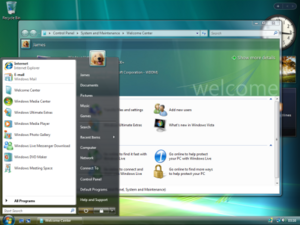Microsoft Windows: Difference between revisions
imported>Eric M Gearhart (Added Windows MCE stuff) |
imported>Joshua David Williams m (changed "to" to "and") |
||
| Line 31: | Line 31: | ||
'''Microsoft Windows''' is the name of several families of [[closed source software]] [[operating system|operating systems]], first released by [[Microsoft]] in [[1985]]. Windows is largely known as holding approximately 90% of the desktop operating system market<ref name=linuxworld>[http://www.linuxworld.com.au/index.php/id;940707233;fp;2;fpid;1 IDC: Consolidation to Windows won't happen] www.linuxworld.com.au</ref> and as having a great number of security threats throughout the years, as it is the most targeted system by [[malware]] developers. Windows is a [[graphical user interface|graphical system]], and was one of the first of its kind to allow input from such devices as a [[mouse (computers)|mouse]]. Before Windows, users of the Microsoft operating systems were limited to plain text operations. | '''Microsoft Windows''' is the name of several families of [[closed source software]] [[operating system|operating systems]], first released by [[Microsoft]] in [[1985]]. Windows is largely known as holding approximately 90% of the desktop operating system market<ref name=linuxworld>[http://www.linuxworld.com.au/index.php/id;940707233;fp;2;fpid;1 IDC: Consolidation to Windows won't happen] www.linuxworld.com.au</ref> and as having a great number of security threats throughout the years, as it is the most targeted system by [[malware]] developers. Windows is a [[graphical user interface|graphical system]], and was one of the first of its kind to allow input from such devices as a [[mouse (computers)|mouse]]. Before Windows, users of the Microsoft operating systems were limited to plain text operations. | ||
Computers running Windows have commonly been referred to as [[Personal Computer|Personal Computers]] (PCs) for many years, as opposed to [[Macintosh|Macs]], [[Workstation computer|workstation computers]], and [[Supercomputer|supercomputers]]. A Windows system is typically found in the home and office environment, completing tasks for nearly every conceivable type of work, from displaying and editing text documents, to [[gaming]] | Computers running Windows have commonly been referred to as [[Personal Computer|Personal Computers]] (PCs) for many years, as opposed to [[Macintosh|Macs]], [[Workstation computer|workstation computers]], and [[Supercomputer|supercomputers]]. A Windows system is typically found in the home and office environment, completing tasks for nearly every conceivable type of work, from displaying and editing text documents, to [[gaming]] and displaying [[X-ray|x-rays]]. A version of Windows (called [[Windows Media Center Edition]] or MCE) is specifically geared toward acting as a "Media hub," providing rich content and various types of leisure, such as watching [[television]] or [[high definition]] movies. | ||
==History== | ==History== | ||
Revision as of 19:05, 7 April 2007
| Microsoft Windows |

|
| Screenshot of Microsoft Windows Vista |
| Website: http://www.microsoft.com/windows/ |
| Developer: Microsoft |
| OS family: Windows NT-based |
| Source model: Closed source |
| Latest stable release: Windows Vista / January 30, 2007 |
| Supported platforms: x86, x86-64 |
| Kernel type: Hybrid microkernel (Windows NT-based) |
| Default user interface: Graphical user interface (Aero) |
| License: MS-EULA |
| Working state: Current |
Microsoft Windows is the name of several families of closed source software operating systems, first released by Microsoft in 1985. Windows is largely known as holding approximately 90% of the desktop operating system market[1] and as having a great number of security threats throughout the years, as it is the most targeted system by malware developers. Windows is a graphical system, and was one of the first of its kind to allow input from such devices as a mouse. Before Windows, users of the Microsoft operating systems were limited to plain text operations.
Computers running Windows have commonly been referred to as Personal Computers (PCs) for many years, as opposed to Macs, workstation computers, and supercomputers. A Windows system is typically found in the home and office environment, completing tasks for nearly every conceivable type of work, from displaying and editing text documents, to gaming and displaying x-rays. A version of Windows (called Windows Media Center Edition or MCE) is specifically geared toward acting as a "Media hub," providing rich content and various types of leisure, such as watching television or high definition movies.
History
There are two development tracks of Windows that were kept updated through subsequent versions: versions of Windows which still relied on an MS-DOS subsystem, and Windows NT, which was written from scratch on a completely new, Hybrid microkernel design.
Windows 1.0 through Windows ME
Windows started life as an attempt at creating a graphical user interface on top of MS-DOS. The first "breakthough" version of Windows that started gaining in popularity was Windows 3.0. Earlier versions weren't feature complete in various ways yet, such as they didn't support overlapped windows, and they couldn't run MS-DOS programs very well. Windows 3.0 changed all that, and combined with the addition of Microsoft Office for Windows, popularity (and sales) of Windows boomed.
Windows NT through Windows Vista
The Windows NT project was created because Microsoft needed an operating system that could compete with Unix workstations in terms of software stability, reliability and scalability. Windows NT was originally intended to complement the MS-DOS based versions of Windows, and provide a viable, marketable platform for businesses.
References
- ↑ IDC: Consolidation to Windows won't happen www.linuxworld.com.au